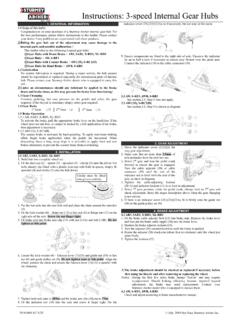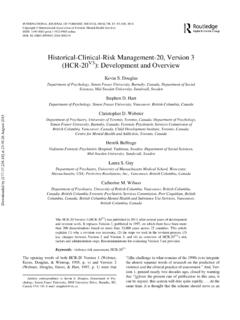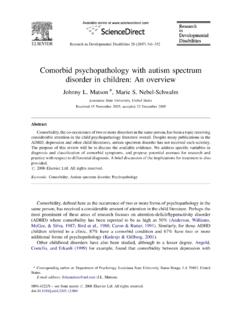Transcription of How to Trick ‘Angry’: Narrative Therapy For People …
1 Psychology & Society, 2008, Vol. 1 (1), 105 115 105 How to Trick angry : Narrative Therapy For People With An Intellectual Disability Who Have Been Referred For Anger Management LUCY HOOLE and SALLY MORGAN University of Surrey Narratives surrounding intellectual disability are largely disempowering, focussing on impairment and defect . Therapeutic approaches are dominated by behavioural theories, which construct the problem as residing within the individual. Systemic theories have started to be applied to Therapy with People with intellectual disabilities. These have proved useful in helping to deconstruct the stories that People tell about themselves.
2 This study is of a Narrative Therapy group, which ran for eight sessions, in a community setting. The theoretical justification for the Therapy is described. We then explain the assessment of potential participants for the group. We outline the three group phases of externalising conversations , exploring exceptions and unique outcomes and developing and anchoring the alternative narratives . Evaluation by feedback and questionnaire is discussed. Reflection on what has been learned is considered: how anger is construed by People with intellectual disabilities, how those narratives can change and what might be the implications of constructing alternative narratives around anger.
3 THE CONTEXT OF THIS WORK This work was carried out in a specialist challenging needs department for People with learning disabilities, accepting referrals from two Community Learning Disability Services. Learning disability is in itself a social construction, and the terminology to describe these difficulties varies across settings and empirical research, for example being described as intellectual disability or learning difficulty . As the inclusion criteria for these services necessitated a diagnosed learning disability as defined by the British Psychological Society (2000) we use this terminology throughout.
4 The service had received a high number of referrals requesting anger management , a significant number of which had been referred in the past with limited success. Referrals for aggressive behaviour are common in learning disability services, and Rose et al (2005) note that such behaviours are the primary reason why People with learning disability are admitted to institutional settings. WHY CHOOSE Narrative Therapy ? A guiding principle behind any intervention for challenging behaviour is that Psychology & Society, 2008, Vol. 1 (1), 105 115 106 Interventions should be delivered in a person centred context and a framework of positive behavioural support.
5 They should include proactive and reactive strategies. (Royal College of Psychiatrists, 2007, p. 10) Traditionally, therapeutic interventions to such behaviours have privileged a behavioural approach (eg. Beail, 2003; Royal College of Psychiatrists, 2007; Sturmey, 2005). Behavioural therapies have the widest evidence base in this area, given the limited research that has been conducted with other therapeutic approaches (Beail, 2003). Sturmey (2005) claims that psychotherapy in particular for People with learning disability has a poor evidence base and should be avoided whenever possible in favour of behavioural interventions.
6 However, it was clear to us that we needed to take a contextual focus on what was happening in People s lives, which traditional behavioural models could not provide. For example, we noted that the service context often necessitates extensive reliance on others to meet personal care needs, which could give rise to feelings of resentment and hostility. A woman assessed for the group (who gave permission for her story to be shared) spoke of how angry she felt when her care staff asked her if she had been for wee wee or a poo poo , despite being in her forties. She often expressed her anger through hitting them as her physical disability precluded her walking away.
7 Furthermore, Rose et al (2005) observe that behavioural interventions do not explicitly encourage self regulation of behaviour; there appears to be an underlying assumption that People with learning disability are not able to self regulate their behaviour. In addition, these methods, by virtue of their underlying theoretical basis of behaviourism cannot attend to underlying emotional experiences. Whilst Taylor et al (2004) observe that anger is not a necessary or sufficient precursor to the occurrence of aggressive behaviours, all of those assessed in our study described feelings of anger they experienced, suggesting that an approach that explicitly attends to these underpinning emotions could be beneficial.
8 Whilst there has been little research focussing on other theoretical approaches, clinicians have increasingly employed cognitive behavioural Therapy (CBT) techniques; the small evidence base has indicated that CBT can significantly reduce self reported anger in People with learning disability (eg. Benson et al, 1986; Rose et al, 2000; Taylor et al, 2002; Willner et al, 2002). Whilst it could be supposed that CBT privileges a self actualising approach (Taylor et al, 2004), Rose (1996) suggests that the behavioural elements are more effective for People with learning disability than the cognitive elements.
9 In addition, Pilgrim and Bentall (1999) observe that CBT is prone to psychological reductionism, as its singular focus on individual cognitive processes can imply that our construction of reality is the problem , rather than the reality itself. In that sense, many interventions inadvertently contribute to the problem by using prescribed methods to fix the person. Given that People with learning disability are already embedded within stories of damage , such interventions could increase stigmatisation. Psychology & Society, 2008, Vol. 1 (1), 105 115 107 For these reasons, we were keen to utilise a theoretical and therapeutic framework that attended to the wider systemic influences on feelings and behaviour, acknowledged underlying emotional experiences and encouraged self regulation of behaviour, without reinforcing stories of damage.
10 Therefore, despite both authors having a strong background in behavioural theory and Therapy , it seemed that a new approach was needed here. A Narrative approach appeared suited to deconstructing the discourses of problem and damage , that have the effect of .. specifying truths and narrow ways of being for People (Zimmerman and Beaudoin, 2002). There has been little research exploring the use of Narrative ways of working with People with learning disability; most evidence in this area is based primarily on case study examples (eg. Clare & Grant, 1994; Fidell, 1997; Lynggaard & Scior, 2002; Perry & Gentle, 1997; Robbins, 2004).





![Instructions for S80[W] Internal Gear Hubs - …](/cache/preview/5/5/4/7/2/3/0/f/thumb-5547230f3a7647a8fb21dbaaaa4b91da.jpg)



